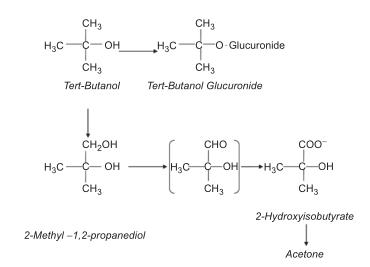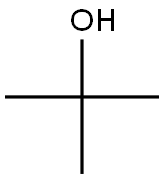Tert-Butanol: a tertiary alcohol and freeze-drying stage
Nov 27,2023
Introduction
Tert-butanol, also known as 2-methyl-2-propanol or tert-butyl alcohol, is a chemical compound with the molecular formula (CH3)3COH. It is a tertiary alcohol and is one of the isomers of butanol. Tert-butanol is a clear, colorless liquid with a strong odor. It is often used as a solvent in various chemical processes and laboratory work. Tert-butanol is soluble in water, but it forms an azeotrope with water, meaning it has a limited miscibility with water at specific concentrations.
Application
Tert-butanol is commonly used as a solvent in various chemical reactions, particularly in the synthesis of organic compounds. It can also be used as a fuel additive, in the production of perfumes and fragrances, and as an extractant in the separation of various compounds.
1.Freeze-drying (lyophilization) is extensively used for the stabilization of thermolabile therapeutic agents. Typically, aqueous solutions of pharmaceuticals are lyophilized, whereas organic solvent–water mixtures are used for lyophilization of pharmaceutical ingredients with poor aqueous solubility. Additional benefits of organic co-solvents for lyophilization include increase in sublimation rate and the corresponding decrease in the drying time, increased drug crystallinity, and stability of the active ingredient The use of a water/tert-butyl alcohol (TBA) system in the manufacturing process of poly-ε-caprolactone (PCL) nanoparticles, namely in the synthesis stage, using the solvent displacement method in a confined impinging jet mixer (CIJM), and in the following freeze-drying stage. The experimental investigation evidenced that the nanoparticles size is significantly reduced with respect to the case where acetone is the solvent. Besides, the solvent evaporation step is not required before freeze-drying as TBA is fully compatible with the freeze-drying process[1]. The effect of initial polymer concentration, flow rate, water to TBA flow rate ratio, and quench volumetric ratio on the mean nanoparticles size was investigated, and a simple equation was proposed to relate the mean nanoparticles size to these operating parameters. Then, freeze-drying of the nanoparticles suspensions was studied. Lyoprotectants (sucrose and mannitol) and steric stabilizers (Cremophor EL and Poloxamer 388) have to be used to avoid nanoparticles aggregation, thus preserving particle size distribution and mean nanoparticles size. Their effect, as well as that of the heating shelf temperature, has been investigated by means of statistical techniques, with the goal to identify which of these factors, or combination of factors, plays the key role in the nanoparticles size preservation at the end of the freeze-drying process. The use of TBA–water systems can confer several advantages –increased stability during processing, more efficient freeze-drying cycle and low residual solvent levels. While the TBA–water system has been studied for over 50 years, the eutectic composition was not known. We are the first to document the composition of the eutectic (the heptahydrate of TBA) and this required low temperature X-ray diffractometry at a synchrotron beamline (Advanced Photon Source)[2].
2. N2O is a greenhouse gas and a candidate oxidant. V olatile organic pollutants (VOCs) have caused great harm to the atmospheric ecological environment. Developing the technique utilizing N2O as the oxidant to oxidize VOCs to realize the collaborative purification has significant importance and practical value for N2O emission control and VOC abatement. Therefore, the study of N2O catalytic oxidation of tert-butanol based on zeolite catalysts was carried out. A series of molecular sieves, including FER, MOR, ZSM-5, Y , and BEA, were selected as the catalyst objects, and the 1.5% wt Fe and Co were, respectively , loaded on the zeolite catalysts via the impregnation method. It was found that the catalytic performance of BEA was the best among the molecular sieves[3].
3.Tert-Butanol is an aliphatic alcohol that is derived commercially from isobutane as a co-product of propylene oxide production and coproduct of tert-butyl hydroperoxide production. It can also be produced by the catalytic hydration of isobutylene. Its largest application is as a raw material for other products Thus, it can be dehydrated to re-form isobutylene, which in its turn is a primary feedstock in the manufacture of synthetic rubber Isobutylene can also be reacted with methanol or ethanol to form the ethers methyl tertiary-butyl ether (MTBE) and ethyl tertiary-butyl ether (ETBE). In addition, high-purity (99%) tert-butanol is used in a large number of diverse, small-scale solvent applications, but it is not used to any significant extent as a solvent for formulated products. Being a tertiary alcohol, tert-butanol is less susceptible to oxidation and less reactive than the other isomers of butanol.
Synthesis
Tert-butanol (2-methyl-2-propanol) can be synthesized through several methods, and one common approach involves the hydration of isobutene. Here's a simplified overview of the synthesis of tert-butanol: Method: Hydration of Isobutene Gather the Required Materials: Isobutene (2-Concentrated sulfuric acid (H2SO4) Water (H2O). Set Up the Reaction: Mix isobutene, concentrated sulfuric acid, and water in a reaction vessel. The concentrated sulfuric acid acts as a catalyst in this reaction. The chemical equation for the reaction is as follows:
C4H8 (isobutene) + H2O (water) → (CH3)3COH (tert-butanol)
Perform the Reaction: Heat the reaction mixture to initiate the hydration of isobutene. This reaction proceeds through the addition of a water molecule to isobutene, forming tert-butanol. Separation and Purification: After the reaction, the mixture will contain tert-butanol along with other by-products. The next step is to separate and purify tert-butanol from the reaction mixture. This can be done through fractional distillation, where the tert-butanol is separated based on its boiling point. Final Product: The collected and purified tert-butanol can be further dried using a drying agent, such as anhydrous magnesium sulfate or calcium chloride, to remove any remaining water. The resulting product is tert-butanol. It's important to note that this is a simplified overview of the synthesis process. In an industrial setting or a laboratory, specific conditions and equipment may be used to optimize the yield and purity of tert-butanol. Additionally, safety precautions should always be followed when working with chemicals and chemical reactions.
Safety
Human exposure to tert-butanol may occur following fuel oxygenate metabolism or biodegradation. It is poorly absorbed through skin, but is rapidly absorbed upon inhalation or ingestion and distributed to tissues throughout the body. Elimination from blood is slower and the half-life increases with dose. It is largely metabolised by oxidation via 2-methyl-1,2-propanediol to 2-hydroxyisobutyrate, the dominant urinary metabolites. Conjugations also occur and acetone may be found in urine at high doses. The single-dose systemic toxicity of tert-butanol is low, but it is irritant to skin and eyes; high oral doses produce ataxia and hypoactivity and repeated exposure can induce dependence. Tert-Butanol is not definable as a genotoxin and has no effects specific for reproduction or development; developmental delay occurred only with marked maternal toxicity. Target organs for toxicity clearly identified are kidney in male rats and urinary bladder, particularly in males, of both rats and mice. Increased tumour incidences observed were renal tubule cell adenomas in male rats and thyroid follicular cell adenomas in female mice and, non-significantly, at an intermediate dose in male mice. The renal adenomas were associated with α2u- globulin nephropathy and, to a lesser extent, exacerbation of chronic progressive nephropathy. Neither of these modes of action can function in humans. The thyroid tumour response could be strain-specific. No thyroid toxicity was observed and a study of hepatic gene expression and enzyme induction and thyroid hormone status has suggested a possible mode of action.It's important to handle tert-butanol with care, as it is flammable and can be harmful if ingested, inhaled, or comes into contact with the skin. Proper safety precautions should be taken when working with this chemical[4].

Figure 1 Major metabolic transformation pathways of tert-butanol in rats.
Reference
1. Zelenkova T, Barresi A A, Fissore D. On the use of tert-butanol/water cosolvent systems in production and freeze-drying of poly-epsilon-caprolactone nanoparticles[J]. J Pharm Sci, 2015,104(1):178-190.
2. Bhatnagar B S, Sonje J, Shalaev E, et al. A refined phase diagram of the tert-butanol-water system and implications on lyophilization process optimization of pharmaceuticals[J]. Phys Chem Chem Phys, 2020,22(3):1583-1590.
3. Wu R, Liu N, Dai C, et al. Collaborative Purification of Tert-Butanol and N2O over Fe/Co-Zeolite Catalysts[J]. International journal of environmental research and public health, 2023,20(6):4902.
4. McGregor D. Tertiary-Butanol: A toxicological review[J]. Critical reviews in toxicology, 2010,40(8):697-727.
- Related articles
- Related Qustion
- What is tert-Butanol? Apr 19, 2021
tert-butyl alcohol, (CH3)3COH, also known as tert-Butanol, is a white crystalline solid or colorless liquid (above 77 °F) with a camphor-like odor. It is soluble in water and miscible with alcohol, ether, and other organic solvents.
Supplementation with pyridoxal 5'-phosphate monohydrate can synthesize neurotransmitters such as dopamine and serotonin, maintaining a healthy nervous system.....
Nov 4,2025Biochemical EngineeringAntioxidant 1010, also known as Irganox 1010, is a synthetic antioxidant used in various industries, including the food, plastics, and rubber industries.....
Nov 27,2023Antioxidantstert-Butanol
75-65-0You may like
- tert-Butanol
-

- $0.00 / 155Kg/Drum
- 2025-12-18
- CAS:75-65-0
- Min. Order: 155KG
- Purity: 99.5%
- Supply Ability: 5000mt
- ert-Butanol
-

- $1.00 / 1kg
- 2025-12-11
- CAS:75-65-0
- Min. Order: 1kg
- Purity: 99%
- Supply Ability: 10 mt
- Anhydrous tert-butanol
-

- $0.00 / 155kg
- 2025-12-05
- CAS:
- Min. Order: 155kg
- Purity: 99%
- Supply Ability: 20 MT






